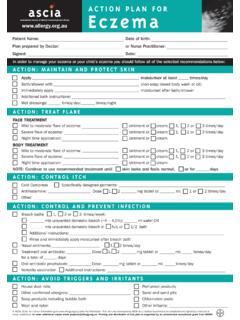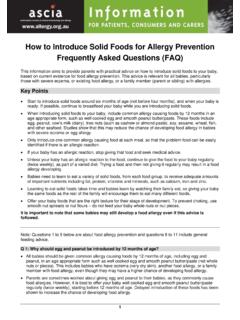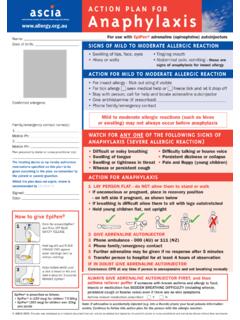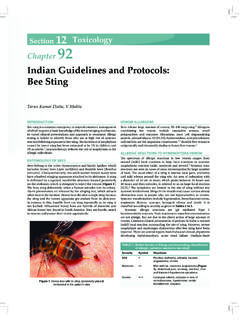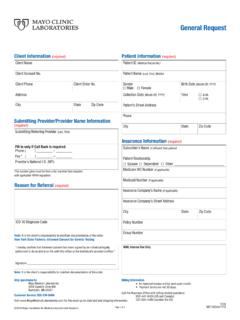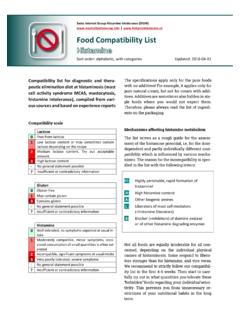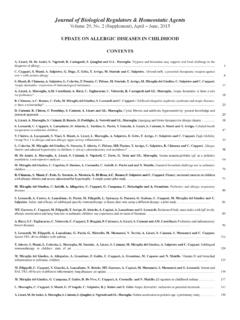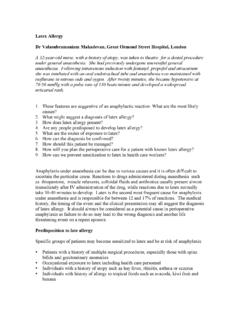Transcription of Antibiotic Allergy Clinical Update
1 Disclaimer: ASCIA information is reviewed by ASCIA members and represents the available published literature at the time of review. The content of this document is not intended to replace professional medical advice and any questions regarding a medical diagnosis or treatment should be directed to a medical practitioner. ASCIA 2014 Antibiotic Allergy Clinical Update This Clinical Update has been adapted, with permission, from the Allergy section of the Therapeutic Guidelines for Antibiotics.
2 The main purpose of this document is to provide an evidence based, quick reference guide to assist primary health care physicians including general practitioners, paediatricians and nurses, in the management of patients with Antibiotic Allergy . Contents 1. Introduction 2 2. Types of Antibiotic hypersensitivity 2 IgE-mediated immediate hypersensitivity IgE-independent reactions Delayed reactions 3. Diagnosis of Antibiotic hypersensitivity 3 Clinical History Skin and blood testing Cross reactivity 4.
3 Management of patients reporting penicillin hypersensitivity 4 References 5 Further Information and resources 6 ASCIA INFORMATION FOR HEALTH PROFESSIONALS 2 1. Introduction While less than 20% of all adverse drug reactions are immune mediated, it is common for a patient to give a history of being 'allergic' to an antimicrobial, usually penicillin. If penicillin is administered to a highly allergic patient, fatal anaphylaxis can occur. However, it is important to consider: Most patients who report a penicillin Allergy have a vague history and are not allergic at all.
4 It is also important not to deny patients treatment with an antimicrobial unnecessarily, especially if they have a serious infection for which that antimicrobial would be the most effective treatment. Hence, evaluation for drug Allergy involves a risk-benefit analysis based on history, Allergy test results (where available) and, if indicated, direct challenge under medical supervision. Risk factors for the Clinical expression of Antibiotic Allergy include: Previous exposure (which may have been non-therapeutic such as in utero or through food products).
5 Aged between 20 and 49 (children and the elderly are at lower risk). Route of administration ( allergic reactions to penicillin occur more frequently following parenteral rather than oral administration). 2. Types of Antibiotic hypersensitivity IgE-mediated immediate hypersensitivity While many reactions are labelled as 'allergic', true IgE-mediated immediate hypersensitivity is characterised by the development of urticaria, angioedema, bronchospasm or anaphylaxis (with objectively demonstrated hypotension, hypoxia or tryptase elevation), usually within one hour of drug administration.
6 If there is more delay, there is less likelihood that the reaction is IgE-mediated. Anaphylaxis is more likely with parenteral rather than oral administration of antibiotics. For penicillin, anaphylaxis occurs at an estimated frequency of 1 to 4 cases per 10 000 courses, with 10% of these reactions being fatal. A clear history of an IgE-mediated reaction means the drug should be avoided, unless the patient can be shown to be no longer allergic by formal skin testing with validated reagents followed by confirmatory drug challenge, or it is introduced using a desensitisation protocol.
7 IgE-independent reactions Reactions mimicking IgE-mediated Allergy ( responses to vancomycin infusions such as 'red-man' syndrome) involve the direct release of vasoactive mediators ( histamine) and may be ameliorated by prophylactic antihistamines and slowing the infusion rate. Delayed reactions Macular, papular, or morbilliform rashes occurring several days after commencement of treatment are more common than immediate reactions, and may be caused by the infection or its treatment.
8 Such reactions are usually T-cell (not IgE) mediated. Skin testing often proves negative. Delayed reactions commonly occur in patients with intercurrent Epstein-Barr virus (especially combined with aminopenicillin treatment) or HIV infection, and such reactions are often not reproducible with deliberate challenge when the patient is well. Viral examthems are common in children. Delayed rashes, especially with aminopenicillins, are not strongly predictive of future reactions and repeat exposure to beta lactams is not ASCIA INFORMATION FOR HEALTH PROFESSIONALS 3 necessarily contraindicated.
9 Patch testing is not recommended for these reactions. The only way to ascertain non-IgE mediated reactions is direct challenge under medical supervision. Three types of delayed reactions warrant special mention: (i) Serum sickness-like reaction, characterised by vasculitic rashes, arthralgia/arthritis, flu-like symptoms and sometimes fever and proteinuria. This response is triggered more commonly with cefaclor than other cephalosporins (also commonly triggered by sulfonamides), and commences several days after the onset of treatment.
10 (ii) Drug rash with eosinophilia and systemic symptoms (DRESS), typically characterised by fever, peripheral blood eosinophilia, rash +/- desquamation and hepatic dysfunction, where re-exposure can be fatal. (iii) Stevens-Johnson syndrome/toxic epidermal necrolysis, the severest cutaneous skin reaction, commonly associated with sulphonamides and nevirapine. These delayed reactions and variants are a contraindication to further drug exposure (including desensitisation). A photographic record of the rash can help with subsequent specialist assessment.
